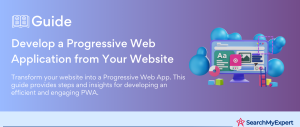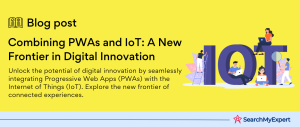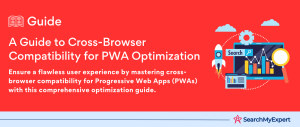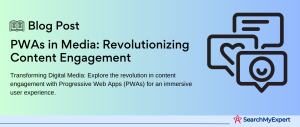Introduction to Progressive Web Apps (PWAs): Revolutionizing the Web Experience
In the digital era, where the internet has become an integral part of daily life, Progressive Web Apps (PWAs) have emerged as a groundbreaking technology. PWAs blend the best of web and mobile apps to offer a superior user experience. This innovative technology is reshaping how users interact with web applications, making them more efficient, accessible, and enjoyable.
What are Progressive Web Apps?
Progressive Web Apps represent a new breed of applications that leverage modern web capabilities to deliver an app-like experience to users. Unlike traditional web pages, PWAs are built using modern web technologies like HTML5, CSS3, and JavaScript, but they offer functionality that was once only associated with native mobile apps. This seamless integration of web and mobile app features is what sets PWAs apart and makes them a game-changer in the web development world.
Key Features and Benefits of PWAs
- Offline Access:
One of the hallmark features of PWAs is their ability to work offline or with a poor internet connection. By utilizing service workers, PWAs can cache important resources, allowing users to access them without an internet connection. This feature significantly enhances the user experience, particularly in areas with unstable internet connectivity. - Fast Loading:
Speed is a critical factor in user retention, and PWAs excel in this regard. Thanks to advanced caching mechanisms, PWAs load much faster than traditional web pages, even on flaky networks. This speed boost not only improves the user experience but also positively impacts search engine rankings. - Discoverability:
Unlike native apps that require downloading from app stores, PWAs are discoverable through search engines. This wider reachability enhances the visibility of the application, making it easier for users to find and engage with it.
Why Build a PWA for Your Project?
Choosing to develop a PWA for your project comes with numerous advantages. The cross-platform nature of PWAs means they can run on any device with a web browser, eliminating the need to develop separate apps for different operating systems. This universality not only reduces development time and costs but also ensures a consistent user experience across all platforms. Additionally, PWAs offer push notifications, a feature that enhances user engagement by keeping them updated with the latest content or features.
Comparison with Traditional Mobile Apps and Websites
When compared to traditional mobile apps and websites, PWAs offer a unique blend of advantages. Unlike mobile apps, PWAs don’t require installation from app stores, making them easily accessible and reducing the barrier to entry for users. They are also generally lighter and consume less device storage. Compared to websites, PWAs offer a more engaging and reliable user experience, closely mimicking the feel of a native app. This hybrid nature of PWAs provides the best of both worlds, making them an ideal choice for businesses looking to enhance their online presence.
As we delve deeper into the world of Progressive Web Apps, it becomes clear that they are not just a passing trend, but a significant step forward in web technology. Their ability to offer a high-quality, app-like experience on the web holds immense potential for businesses and developers alike. The following sections will explore more about how to harness the power of PWAs, their implementation, and real-world success stories, further illustrating why PWAs are the future of web development.
Planning and Ideation: Laying the Foundation for a Successful Progressive Web App
Embarking on the journey of developing a Progressive Web App (PWA) requires meticulous planning and strategic ideation. This stage is crucial as it lays the groundwork for what the app will become. Here, we delve into the key steps involved in planning and ideating a PWA, ensuring that the end product is not only functional but also aligns perfectly with the needs of its intended users.
Identifying Your PWA’s Purpose and Target Audience
- Understanding the Purpose: Before diving into development, it’s essential to clearly define the purpose of your PWA. What problem does it solve? How does it add value to the user’s life? Answering these questions will guide the entire development process, ensuring that the PWA is tailored to meet specific needs.
- Defining the Target Audience: Knowing your audience is crucial. Different demographics have varying needs and preferences. Conduct market research to understand your audience’s behaviors, preferences, and technological capabilities. This understanding will inform design decisions and functionality, making the PWA more appealing and useful to your target audience.
Defining Core Functionalities and User Journeys
- Listing Core Functionalities:
Identify the essential features your PWA must have. These should align with your app’s purpose and meet user needs. Prioritization is key; focus on what’s necessary for launch, and consider additional features for future updates. - Mapping User Journeys:
Envision how users will interact with your PWA. Map out user journeys to visualize the path users will take to complete actions. This step is vital for creating an intuitive and user-friendly interface.
Sketching Wireframes and Low-Fidelity Prototypes
- Creating Wireframes:
Start with sketching wireframes. This process involves drawing basic outlines of your PWA’s pages and showing the placement of elements such as buttons, text, and images. Wireframes are crucial for visualizing the layout and structure of your PWA. - Developing Low-Fidelity Prototypes:
These are basic, interactive models of your PWA. They provide a preliminary look at how users will interact with the app, allowing you to test and refine the user experience early in the development process.
Choosing the Right Tools and Technologies
- Selecting Front-End Frameworks:
Choose a front-end framework that aligns with your PWA’s requirements. Popular choices include React, Angular, and Vue.js. These frameworks provide robust environments for developing dynamic and responsive PWAs. - Implementing Service Workers: Service workers are essential for offline functionality and background tasks. They act as a proxy between the web app and the network, allowing for efficient resource management and improved user experience.
- Other Considerations: Depending on your PWA’s complexity, you may need additional tools such as Webpack for module bundling, or Workbox for simplifying service worker implementation.
Building the UI and Front-End: Crafting an Engaging and Responsive PWA Experience
The process of building the user interface (UI) and front-end of a Progressive Web App (PWA) is a critical phase where design meets functionality. This step is about translating the planned design and features into a tangible, interactive experience. It involves setting up a development environment, coding for responsiveness, implementing core features, and optimizing for performance. Let’s delve into each of these aspects to understand how to build an effective and efficient PWA.
Setting Up Your Development Environment
- Choosing the Right IDE:
Select an Integrated Development Environment (IDE) that supports web development, such as Visual Studio Code or WebStorm. These IDEs offer features like syntax highlighting, code completion, and version control integration, making the development process smoother. - Configuring Development Tools: Install necessary tools like Node.js, npm (Node Package Manager), and relevant frameworks/libraries (e.g., React, Angular, Vue.js). Ensure you have the latest versions to take advantage of the latest features and security updates.
- Establishing a Version Control System:
Utilize a version control system like Git. This allows for efficient tracking of changes, collaboration with other developers, and maintaining a stable development process.
Coding the User Interface for Different Screen Sizes (Responsive Design)
- Utilizing CSS Frameworks:
Employ CSS frameworks like Bootstrap or Foundation to facilitate responsive design. These frameworks come with pre-defined styles and components that adjust gracefully to different screen sizes. - Media Queries:
Implement media queries in your CSS to create a truly responsive design. This ensures your PWA looks and functions seamlessly on devices of all sizes, from smartphones to desktops. - Testing Across Devices:
Regularly test your PWA on various devices to ensure compatibility and responsiveness. Tools like Chrome DevTools can simulate different screen sizes and environments.
Implementing Core Features and Functionalities
- Developing Key Components:
Start by coding the essential features identified in your planning phase. This may include navigation bars, search functionality, forms, and other interactive elements. - Ensuring Interactivity:
Use JavaScript to add interactivity to your PWA. This includes handling user inputs, fetching data, and dynamically updating the UI. - Utilizing APIs:
Incorporate various APIs for added functionality. For example, use the Geolocation API for location-based services or Web Storage API for storing data locally.
Optimizing Performance for Fast Loading
- Minimizing Code: Use tools like Webpack or Rollup for bundling and minifying your JavaScript and CSS files. This reduces the size of your files, leading to faster loading times.
- Optimizing Images and Assets: Compress images and use modern formats like WebP for improved performance. Also, consider using SVGs for icons and graphics as they scale well and have a small file size.
- Implementing Lazy Loading:
Implement lazy loading for images and non-critical resources. This means they are only loaded when needed, improving initial load times. - Caching Strategies:
Use service workers for caching important assets and enabling offline capabilities. Efficient caching can significantly enhance the speed and performance of your PWA.
implementing PWA Essentials: Enhancing Functionality and User Engagement
Progressive Web Apps (PWAs) stand out due to their ability to offer a near-native app experience within a browser. This is largely attributed to certain PWA-specific features like offline functionality, asset pre-caching, the inclusion of a manifest file, and the ability to send push notifications. This step focuses on implementing these essential elements, which are crucial for elevating your PWA’s functionality and overall user experience.
Setting Up a Service Worker for Offline Functionality
- Understanding Service Workers:
A service worker is a script that your browser runs in the background, separate from a web page, opening the door to features that don’t need a web page or user interaction. It’s a key technology behind offline functionality in PWAs. - Implementing the Service Worker:
To add a service worker to your PWA:
- Register the service worker in your main JavaScript file.
- Write the service worker script, where you’ll define how to handle network requests and caching strategies.
- Test the service worker to ensure it’s working correctly, particularly its ability to handle offline scenarios.
Pre-Caching Essential Assets and Resources
- Identifying Essential Assets: Determine what resources are essential for your PWA to function offline. This typically includes HTML files, CSS stylesheets, JavaScript files, and key images.
- Implementing Caching Strategies: Use the Cache API within your service worker to pre-cache these essential assets. You’ll want to add these resources to the cache when the service worker installs.
- Updating Cached Assets:
Implement a strategy to update assets in the cache when new versions are available. This ensures that your users are always experiencing the most up-to-date version of your PWA.
Adding a Manifest File for Offline Splash Screen and Installation
- Creating a Web App Manifest: The manifest file is a JSON file that controls how your app appears to the user and defines its appearance at launch. It includes metadata like names, icons, and splash screen colors.
- Configuring the Manifest:
Include icons for different screen sizes, specify the app’s name, short_name, start_url, display (e.g., standalone, fullscreen), and background_color for the splash screen. - Linking the Manifest:
Add a link to the manifest file in the HTML head of your PWA for it to be recognized by the browser.
Sending Push Notifications (Optional)
- Understanding Push Notifications: They are a powerful tool for increasing user engagement. Through service workers, your PWA can send notifications to users even when it’s not open in a browser.
- Implementing Push Notifications:
- Request user permission for sending notifications.
- Implement the push API in your service worker to handle notification events.
- Ensure backend support for sending push messages.
- Crafting Effective Notifications:
Make sure your notifications are timely, relevant, and valuable to your users. Avoid overuse to prevent notification fatigue.
Testing and Deploying Your PWA: Ensuring Quality and Accessibility
The successful launch of a Progressive Web App (PWA) hinges not just on its development but equally on thorough testing and strategic deployment. This phase involves rigorous testing across various devices and network conditions, debugging to ensure optimal performance and offline functionality, deploying the PWA on suitable platforms, and setting up tools for analytics and monitoring. Each of these steps is crucial in guaranteeing that your PWA delivers the intended user experience and meets the set objectives.
Testing for Different Devices and Network Conditions
- Cross-Device Testing: Ensure your PWA functions seamlessly across a range of devices (smartphones, tablets, desktops) and operating systems (iOS, Android, Windows). This involves testing for responsive design, touch interactions, and screen orientations.
- Network Condition Testing:
Simulate different network environments, including offline, slow 3G, and 4G, to ensure your PWA performs well under various conditions. Tools like Chrome DevTools can be helpful for this. - Browser Compatibility Testing:
Verify that your PWA works correctly across different browsers (Chrome, Firefox, Safari, Edge). This is crucial as different browsers may handle certain web technologies differently.
Debugging Performance Issues and Ensuring Offline Functionality
- Performance Debugging:
Utilize tools like Lighthouse and WebPageTest to identify performance bottlenecks. Focus on optimizing load times, interactive elements, and smooth animations. - Offline Functionality Testing:
Rigorously test the offline capabilities of your PWA. Ensure that all pre-cached assets load correctly and that the app maintains functionality during network disruptions.
Deploying Your PWA to Various Hosting Platforms
- Web Hosting Choices:
Select a suitable web hosting platform that aligns with your PWA’s needs. Popular options include AWS, Google Cloud, and Netlify. Consider factors like scalability, reliability, and cost. - App Stores: While PWAs are primarily accessed through browsers, they can also be packaged and submitted to app stores like Google Play and the Microsoft Store, broadening their reach.
- Deployment Process:
The deployment should be automated as much as possible to reduce human error. Implement continuous integration/continuous deployment (CI/CD) pipelines for efficient and reliable updates.
Setting Up Analytics and Monitoring Tools
- Implementing Analytics:
Use tools like Google Analytics to track user engagement, retention, and app performance. This data is invaluable for understanding how users interact with your PWA and where improvements can be made. - Monitoring Performance and Health: Employ monitoring tools to keep an eye on your PWA’s performance and stability. Services like Sentry, New Relic, or Firebase can alert you to issues in real time.
- Feedback Loop: Establish a system for gathering and analyzing user feedback. This can guide future updates and enhancements to your PWA.
Optimizing and Promoting Your PWA: Maximizing Reach and Engagement
Once your Progressive Web App (PWA) is up and running, the focus shifts to optimization and promotion. This stage is crucial for ensuring that your app not only reaches its target audience but also provides a continually improving user experience. By analyzing user engagement, employing A/B testing, implementing SEO strategies, and leveraging content marketing and social media, you can significantly enhance your PWA’s performance and visibility.
Analyzing User Engagement and App Usage Data
- Utilizing Analytics Tools:
Deploy tools like Google Analytics to gain insights into how users are interacting with your PWA. Look at metrics such as user retention, session duration, and conversion rates to understand user behavior. - Interpreting Data for Improvement:
Use the data collected to identify areas that need improvement. For instance, if certain pages have high bounce rates, they may require better content or faster loading times.
Making A/B Testing and Iterative Improvements
- Conducting A/B Testing: Implement A/B testing to compare different versions of your PWA’s features or design. This can include testing different layouts, color schemes, or call-to-action buttons to see which performs better.
- Iterative Development:
Based on the results from A/B testing, make iterative improvements to your PWA. This approach ensures continuous enhancement based on actual user feedback and behavior.
Implementing SEO Best Practices for Discoverability
- Optimizing for Search Engines: Ensure your PWA is easily discoverable by search engines. This includes optimizing page titles, and meta descriptions, and using structured data to enhance search listings.
- Mobile-First Indexing: As PWAs are particularly geared towards mobile users, ensure your site follows mobile-first indexing best practices, such as responsive design and fast loading speeds.
- Content Optimization:
Regularly update your PWA with relevant and keyword-rich content. This not only helps with SEO but also keeps your content fresh and engaging for users.
Promoting Your PWA Through Content Marketing and Social Media
- Content Marketing Strategy:
Develop a content marketing strategy that positions your PWA as a solution to your target audience’s needs. This could include blog posts, how-to guides, and case studies. - Leveraging Social Media:
Use social media platforms to promote your PWA. Share updates, engage with your audience, and use targeted ads to reach potential users. - Email Marketing:
Consider an email marketing campaign to inform existing customers about your new PWA, its features, and benefits. - Collaborations and Partnerships:
Partner with influencers or other brands to expand your reach. This can help you tap into new audiences and gain credibility.
Maintaining and Updating Your PWA: Ensuring Longevity and User Satisfaction
The launch of a Progressive Web App (PWA) marks the beginning of its lifecycle, not the end. Post-launch, it’s crucial to maintain and update the app regularly. This process involves addressing user feedback, fixing bugs, adding new features, staying updated with the latest PWA technologies, and ensuring the app’s long-term performance and user satisfaction. Let’s explore each of these aspects to understand how to keep your PWA at the forefront of technological advancement and user preference.
Addressing User Feedback and Fixing Bugs
- Monitoring User Feedback:
Actively monitor user feedback from various channels, including app reviews, social media, and direct user communications. This feedback is invaluable for identifying issues and areas for improvement. - Prioritizing and Fixing Bugs:
Regularly update your PWA to fix bugs and address any security vulnerabilities. This not only improves the app’s performance but also builds trust with your users.
Adding New Features and Functionalities
- Evolving User Needs:
Stay attuned to your users’ changing needs and preferences. Adding new features and functionalities can keep your PWA relevant and engaging for your audience. - Iterative Development:
Implement an iterative development approach. This means releasing small updates frequently, which allows you to adapt quickly to user feedback and changing market trends.
Staying Up-to-Date with the Latest PWA Technologies and Best Practices
- Continuous Learning:
The world of web technology is constantly evolving. Stay informed about the latest developments in PWA technologies, such as new APIs, frameworks, and best practices. - Adopting New Technologies:
Be open to integrating new technologies into your PWA. This could mean anything from using new web APIs to adopting more efficient coding practices or frameworks.
Ensuring Long-Term Performance and User Satisfaction
- Performance Optimization: Continuously monitor and optimize your PWA’s performance. This includes speeding up load times, optimizing images and assets, and ensuring the app runs smoothly across all devices and browsers.
- User-Centric Approach: Always prioritize user satisfaction. This means not only addressing their current needs but also anticipating future expectations and trends.
- Regular Updates:
Keep your PWA fresh and engaging with regular content updates, design refreshes, and feature enhancements.
Conclusion:
The journey of creating and nurturing a Progressive Web App (PWA) encompasses a broad spectrum of activities, from initial planning and ideation to the ongoing process of maintenance and updates. Each step, whether it’s designing a responsive UI, implementing core PWA functionalities, or optimizing and promoting the app, plays a crucial role in shaping the success and effectiveness of your PWA. By staying attuned to user feedback, keeping abreast of the latest technological advancements, and continually refining and enhancing your app, you can ensure that your PWA remains a dynamic, efficient, and user-friendly platform. As PWAs continue to evolve, they stand as a testament to the innovation and adaptability of web technologies, offering a glimpse into the future of how we interact with the digital world. Remember, the key to a successful PWA lies not just in its technical prowess but in its ability to connect with and provide value to its users.
Elevate your user engagement with Progressive Web App Service Companies.
Table of Contents
Toggle






